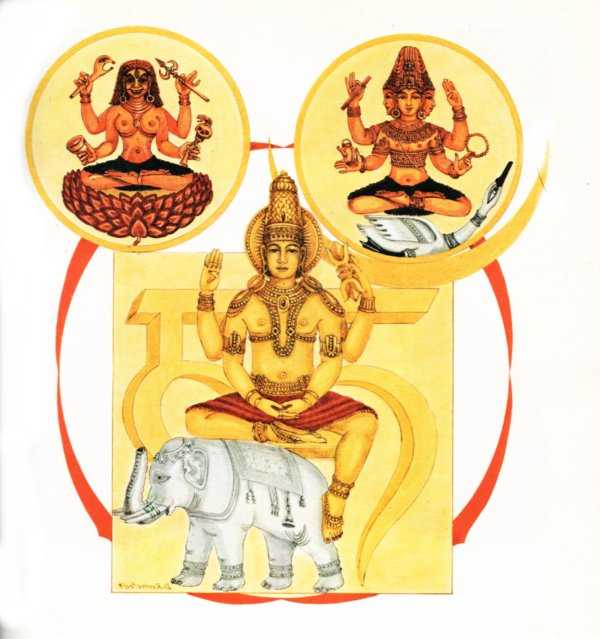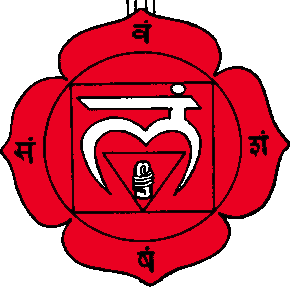ICM Library Foundation
|
The Muladhara Chakra. Chakra 1 |
|
Image and Description.
|
The Muladhara is one of the seven Primary Chakras, and is associated with the element: Earth, representing the densest grade of manifestation. In the Kundalini-yoga system of Shaktism, the Muladhara Centre is described as having four petals, corresponding to the psychological states of greatest joy, natural pleasure, delight in controlling passions, and blissfulness in concentration. All these qualities correspond to the bliss of realising the Divine in the physical body. |
The highest and most complete forms of spirituality do not reject the body, but see it as the vehicle for the transmutation of the body and the spirit together.
It is, according to Shakta Tantric doctrine, the seat of Kundalini, the latent cosmic energy or shakti that resides in every living being. When this latent power is activated through Hatha Yoga practicises (pranayama, purification of the nadis, etc), it rises through each of the rear or spinal chakras, and up through the top of the head, to the Sahasrara or "Thousand Petalled Lotus" located above the crown. There it unites with its opposite polarity, the Paramashiva or Supreme Godhead Consciousness, and the yogi attains total Liberation from phenomenal reality.
Colours associated with this chakra are red, yellow, and golden. It could be considered the bliss centre for physical body.
Deities within the Muladhara Chakra.
 |
|
Clockwise
from the bottom: |
Table for Muladhara Chakra 1.
| Terminology | Tantric | muladhara, adhara, mula chakra or padma, brahma padma or bhumi chakra, chaturdala, chatuhpatra |
| Vedic (late Upanishads) | muladhara, adhara, mulakanda, brahma | |
| Puranic | muladhara, adhara | |
| Position | externally, perineal region, close to anus | |
| Petals | number | four; arranged from right to left |
| colour | blood-red (deep red), shining red, yellow, golden (shining yellow) | |
| Matrika-letters | on petals | four in number; Wang Shang Shang Sang, arranged from right to left |
| colour | gold (shining yellow), blood red (deep red) | |
| Vrittis | on petals | four in number; arranged from right to left |
| name | 1 greatest joy; 2 natural pleasure; 3 delight in controlling passion; 4 blissfulness in concentration | |
| In the pericarp | quadrangular Earth-region | |
| colour of the Earth Region | yellow, golden (shining yellow) | |
| Earth-bija (in Earth Region) | Lang | |
| colour of Earth-bija | yellow, shining yellow | |
| Form of Earth-bija | deity Indra | |
| Concentration form of Indra | Indra is yellow in colour, four-armed, holding the Vajra and a blue lotus in his hands, mounted on the white elephant Airawata | |
| In the bindu of Lang | deity Brahma | |
| Concentration form of Brahma | Brahma is deep red, young, four-faced, three-eyed, four-armed, holding a staff, a sacred water-pot, and a rosary of rudraksha, and making the gesture of dispelling fear; seated on a swan | |
| Presiding divinity | power Dakini | |
| Concentration of Dakini | Dakini is shining red or shining white in colour; she has beautifull face with three eyes; four-armed, holding a trident, a skulled staff, a swan and a drinking vessel; seated on a red lotus | |
| Triangle colour | shining deep red | |
| Swayambhu-linga | location | inside the triangle |
| form | broad at the bottom and tapers to a point at the top | |
| colour | shining deep red, black (or green), golden (shining yellow) | |
| Kundalini as Kula-Kundalini | Supremely subtle, lightning-like splendorous; also of shining red, white and black (or dark-green) colour; in three and a half coils around Swayambhu-linga | |

